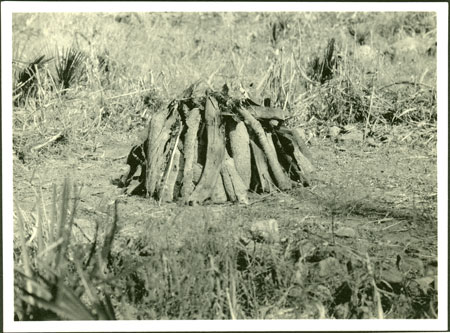Ingessana pot firing

103 x 76 mm | Print gelatin silver
There are records relating to alternative images that we do not have scans for in the database:
1998.344.47.1 - Negative film nitrate , (103 x 76 mm)
1998.344.47.1 - Negative film nitrate , (103 x 76 mm)
Date of Print:
Unknown
Previous PRM Number:
EP.D.47
Previous Other Number:
J 8
Accession Number:
1998.344.47.2
Description:
A pile of bark strips covering coil-technique clay pots to be fired.
Pots were made by women who sold them as far south as Ulu hill.
The clay for the several types of pot made by the Ingessana was most commonly tempered with fine grass and water and decorated using a piece of gourd, a pebble, and grass stems.
Photographer:
Edward Evan Evans-Pritchard
Date of Photo:
1926 November - December
Region:
Blue Nile Tabi Hills ?Soda
Group:
Ingessana (Gaam)
PRM Source:
Edward Evan Evans-Pritchard
Acquired:
Donated 1966
Other Owners:
E. E. Evans-Pritchard Collection
Class:
Fire , Pottery
Activity:
Firing
Documentation:
Original catalogue lists in Manuscript Collections. Additional material in related documents files. [CM 27/9/2005]
Primary Documentation:
PRM Accession Records - Accession Book Entry [p.
98] 1966.27 [1 - 24] G[ift] PROFESSOR E.
E.
EVANS-PRITCHARD; INST.
OF SOCIAL ANTHROPOLOGY, 51 BANBURY RD.
OXFORD - 1966.27.19 - S.
SUDAN, DARFUNG.
VARIOUS TRIBES.
Box of negatives in envelopes, [1 - 242] & 1966.27.20 - Box of prints of these negatives [refers to object 1966.27.19] [1 - 242], in envelopes.
Manual Catalogues [typewritten, entitled "Ingassana"] - 47. Firing pots. J.8
Note on print reverse ms pencil - "Pots firing (duplicate) J8"
Manual Catalogues [typewritten, entitled "Ingassana"] - 47. Firing pots. J.8
Note on print reverse ms pencil - "Pots firing (duplicate) J8"
Other Information:
In A Preliminary Account of the Ingassana Tribe in Fung Province, Sudan Notes and Records X, 1927, page 77-8, E.
E.
Evans-Pritchard notes that 'Pots are made by women...there is a large export trade in these pots, the women travelling as far south as hill Ulu to sell them.
The women make several kinds of pot, those which in Arabic are called kantush, tebar, doka, all being made.
There are two different kinds of clay which are used in the making of the pots.
The method which is employed in building them up is that which is known as the coil technique.
The clay is mixed with fine grass and water, and a piece of gourd, a pebble, and a piece of grass for incising patterns are the only instruments used in the manufacture.' [Chris Morton 2/2/2004]
Recorder:
Christopher Morton 3/2/2004 [Southern Sudan Project]

